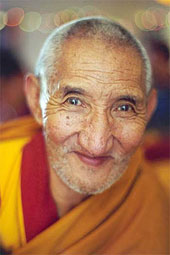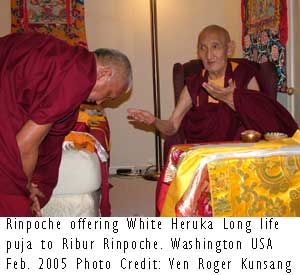
Ven. Ribur Rinpoche
When Ribur Rinpoche was fourteen he entered Sera Mey monastery, one of the great Gelug monastic-universities in Lhasa, to begin intensive studies in Buddhist philosophy. During his stay at Sera Monastery, Rinpoche also attended many teachings and initiations given by his root guru, Pabongka Rinpoche, the greatest Gelug lama of the time.Ribur Rinpoche was born in the Kham region of Tibet in 1923, and at aged 5, was recognized by the Thirteenth Dalai Lama as the reincarnation of the head lama of Ribur Monastery, the sixth incarnation of Lama Kunga Osel. This Lama was famed for being a great scholar and teacher who spent the last twelve years of his life in strict solitary retreat. All five of the previous incarnations were principal teachers at Ribur Monastery in Kham.
After studying at Sera Mey Monastery, Rinpoche received his Geshe degree in 1948 at the age of 25. Rinpoche returned to Kham where he spent many years doing retreat in a small hut he had built in the forest. But after the Chinese Communist invasion in 1950, the situation in Kham became increasingly dangerous, and in 1955 he was advised by one of his gurus, Trijang Rinpoche, to return to Lhasa, where he continued to take teachings and do retreats.
But Lhasa itself soon became unsafe. From 1959 (the year of the Tibetan people’s uprising) to 1976, Rinpoche was confined in Lhasa, during which time he experienced relentless interrogation and torture during 35 of the infamous struggle sessions. “If I told you what happened on a regular basis, you would find it hard to believe.”
Rinpoche experienced numerous hardships and difficulties such as imprisonment and physical abuse, and being a helpless observer of the terrible destruction of the Cultural Revolution. However, during this time he was able to keep his mind peaceful and even happy by practising the teachings he had learned. As Rinpoche described his experiences, “I didn’t really experience the slightest difficulty during those adverse conditions. This was due to the kindness of Lama Dorje Chang [Pabongka Rinpoche]. From him I had somehow learned some mental training, and in those difficult times, my mind was immediately able to recognise the nature of cyclic existence, the nature of afflictive emotions, and the nature of karma and so forth. So my mind was really at ease.”
At the end of the Cultural Revolution in 1976, Ribur Rinpoche spent more than 10 years in Chinese labor camps and was given a job with the Religious Affairs Office in Tibet.

On one of his trips to China, he worked with the Panchen Lama to restore as many of the lost spiritual treasures of Tibet as they could. His main accomplishment was recovering the two most precious statues of Shakyamuni Buddha: the Jowo Chenpo and the Ramo Chenpo. These two statues, originally brought to Tibet by the Chinese and Nepalese wives of King Songsten Gampo (ca 617-698), were taken to Beijing during the Cultural Revolution and kept in various warehouses along with thousands of other statues for 17 years, until Rinpoche found them and returned them to their respective temples in Lhasa. He also re-established the destroyed stupa of Lama Tsongkhapa, which contained some of Lama Tsongkhapa’s bodily relics.
In 1987 Rinpoche left Tibet and travelled to Dharamsala, India, to see His Holiness the Dalai Lama. Since then he has lived at Namgyal Monastery in Dharamsala, where, at the request of His Holiness, he wrote a number of biographies of great lamas, such as that of the 13th Dalai Lama, and an extensive religious history of Tibet, which includes his autobiography.
Ribur Rinpoche spent many years living in northern California where he gave teachings and led retreats. Rinpoche also visited and taught in several foreign countries – Australia, New Zealand, America, and around Europe – before returning to India, where he passed away in 2006.
Tenzin Pasang Rinpoche: The Current Incarnation
 Tenzin Pasang, a young Tibetan boy living near Sera Me Monastery, has been recognised by His Holiness Dalai Lama as the reincarnation of Ribur Rinpoche. When they met in Bodhgaya in early 2010, Lama Zopa Rinpoche offered the young tulku an enthronement ceremony attended by senior Sangha, and family members and close students of the late Ribur Rinpoche. It is expected that Tenzin Pasang Rinpoche will study at Sera Me when he is older.
Tenzin Pasang, a young Tibetan boy living near Sera Me Monastery, has been recognised by His Holiness Dalai Lama as the reincarnation of Ribur Rinpoche. When they met in Bodhgaya in early 2010, Lama Zopa Rinpoche offered the young tulku an enthronement ceremony attended by senior Sangha, and family members and close students of the late Ribur Rinpoche. It is expected that Tenzin Pasang Rinpoche will study at Sera Me when he is older.
Sources:
FPMT (http://www.fpmt.org/teachers/ribur.asp)
Lama Yeshe Wisdom archive (http://www.lamayeshe.com/index.php?sect=article&id=433)
(http://www.lamayeshe.com/index.php?sect=author&subsect=bio&id=48)









































 English
English Indonesia
Indonesia Tibetan
Tibetan
Sarah
January 16, 2011
In 1997, Ribur Rinpoche went to Singapore twice and gave teachings on how to develop the precious bodhimind. Rinpoche also taught lojong, using his personal experience. His teachings have been published in a small book entitled “How to Generate Bodhicitta”, published by the Amitabha Buddhist Centre, Singapore. A great being indeed and a real Bodhisattva.
vajrastorm
January 19, 2011
Ribur Rinpoche has accomplished much in his lifetime. After receiving his Geshe degree, he returned to Kham(where the monastery of his line of incarnations, the Ribur Monastery, was located). There he spent years in retreat. Then, when Tibet was invaded by the Chinese Communists, he followed Kyabje Trijang Rinpoche’s instructions and relocated to Lhasa, where he continued to receive teachings and to do retreats.
He was also deeply involved in helping the Panchen Lama in the restoration of many lost spiritual treasures of Tibet. His particular accomplishment was the recovery of the two famous statues of Buddha Shakyamuni: the Jowo Chenpo and the Ramo Chenpo and their restoration to their respective temples in Lhasa. He also re-established the destroyed stupa of Lama Tsongkhapa, which contained some of Je Tsongkhapa’s body relics.
Later, when he left Tibet(in 1987)and resided in India, he wrote biographies of great lamas and an extensive history of Tibet(at the request of the Dalai Lama). He also spent many years living in California and visiting foreign countries , like Australia, New Zealand, America and some European countries. In California, he gave teachings and led retreats. Elsewhere, he focused on giving teachings to spread the pure Dharma of Je Tsongkhapa all over the world.
However, despite his many accomplishments, he says (in his ‘A Memoir of Pabongka Rinpoche’ ):
“The only thing that matters to me is that I was a disciple of Pabongka Rinpoche”.
His love and devotion to this great master whom he considers “the most important Tibetan Lama of all times” can be seen throughout his own life story. For example, he says he was able to endure all the hardship and torture in the hands of the Chinese Communist because he had put into practice the teachings of Pabongka Rinpoche. He had learnt much about mind training from Pabongka Rinpoche; so he was able to keep his mind peaceful and happy during these terrible times of great trial and tribulations by putting all of it into practice.
May his incarnation continue his great work as a teacher to spread the teachings of Je Tsongkhapa and the Gelugpa lineage everywhere, for the benefit of all beings.
Sierra
July 26, 2016
His Eminence Ribur Rinpoche is such a great master. To be so learned scholar and still doing long retreats in the forest. And, in his later years to be travelling to the western countries giving teachings. He wrote many biograhies of many lamas as well.
The real test of his attainments, to me, is when he said that he was able to keep his mind peaceful and even happy by practicing the teachings he had learned due to the kindness of Lama Dorje Chang [Pabongka Rinpoche].
To read that it was His Eminence Ribur Rinpoche who recovered the two most precious statues of Shakyamuni Buddha: the Jowo Chenpo and the Ramo Chenpo which were originally brought to Tibet by the Chinese and Nepalese wives of King Songsten Gampo (ca 617-698). To think that despite being taken to Beijing during the Cultural Revolution and kept in various warehouses along with thousands of other statues for 17 years, Rinpoche found them and returned them to their respective temples in Lhasa.
Such skill in re-establishing the destroyed stupa of Lama Tsongkhapa, which contained some of Lama Tsongkhapa’s bodily relics in Tibet.
May Tenzin Pasang Rinpoche, the current incarnation grow up to continue the works of His Eminence Ribur Rinpoche.
Anonymous
December 29, 2017